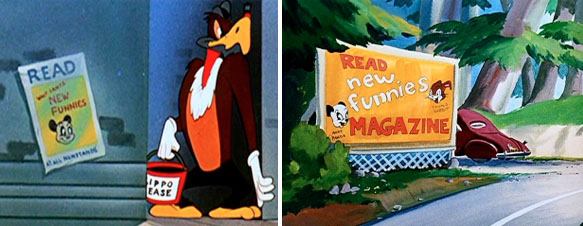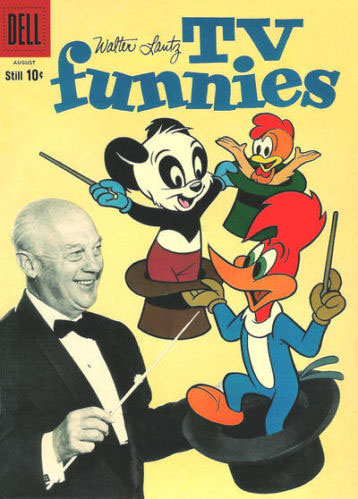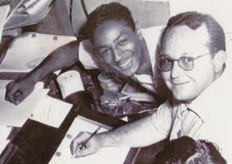
It Pays To Advertise. At the beginning of Wet Blanket Policy (1948) is an advertisment for the DELL comic book New Funnies that featured stories of the Walter Lantz characters. A billboard in Well Oiled (1947) also promotes the comic book. DELL’s comic book The Funnies switched formats and title to become New Funnies with issue #65 (July 1942) featuring characters like Oswald the Rabbit, Andy Panda and Woody Woodpecker. The title changed again with issue #109 (March 1946) to Walter Lantz New Funnies. The comic book lasted through issue #288 (April 1962).

The Music Rights Stuff. Ski For Two (1944), a Woody Woodpecker cartoon has a sequence (animated by Dick Lundy) of Woody skiing and singing the melody The Sleigh (a la Russe) (written in 1926 by Richard Kountz and Ivor Tchervanow). This song was used under the belief that it was in public domain. It was not as was discovered shortly before the cartoon was completed. Rather than re-edit the animation to a different song, Walter Lantz sent fifty dollars to the publishing firm for the use of the music. The firm sent back a letter stating that it would only accept one hundred dollars for the use of the song and Lantz complied.
Roger Rabbit Vs. Mickey Mouse. When Who Framed Roger Rabbit (1988) was released, author Gary Wolf who wrote the book that inspired the movie was interviewed in the Boston Herald newspaper. “People are now meeting in all manner of places, in small rooms based on something I did to amuse myself over my kitchen table. Roger is really a character for the 1980s. He’s got more angst than some of the older cartoon characters and he goes through all kinds of emotions. You wouldn’t see Mickey Mouse do that.”
 Bakshi Never Watches His Own Films. “I had so little money to make these (Bakshi’s earliest animated features) that all I see are the flaws. I can’t stand to look at my old movies. I don’t look at my movies after I finish them because I see how terrible some of the animation was and I know I’d never made another film if I looked at them. The only way I protect myself is to keep the initial memory going in my mind of what I was after Wizards was certainly based on my love of sword and sorcery and I grew up on comics and comic books. I would love to make a sequel to Wizards as it was made with continuing characters,” stated animator and director Ralph Bakshi in an interview in 1988.
Bakshi Never Watches His Own Films. “I had so little money to make these (Bakshi’s earliest animated features) that all I see are the flaws. I can’t stand to look at my old movies. I don’t look at my movies after I finish them because I see how terrible some of the animation was and I know I’d never made another film if I looked at them. The only way I protect myself is to keep the initial memory going in my mind of what I was after Wizards was certainly based on my love of sword and sorcery and I grew up on comics and comic books. I would love to make a sequel to Wizards as it was made with continuing characters,” stated animator and director Ralph Bakshi in an interview in 1988.
Disney Steals a Song. Walt Disney, his staff, and most of the general public were under the impression that the song “Steamboat Bill” written by Leighton Brothers and Ren Shields was in public domain. It became the main theme for the first Mickey Mouse cartoon in synchronized sound, Steamboat Willie (1928). The song was still under copyright. As Disney historian Michael Barrier discovered Columbia Pictures (who were then distributing Mickey Mouse shorts beginning in 1930) paid a license settlement fee of $150 on April 25, 1931 for permission to use the song in Steamboat Willie.
Animated Projects That Never Were. In 1999, Disney contacted John Kricfalusi to develop a new animated series entitled Green Monkeys about two green monkeys working a temp agency. The project had been developed internally at Disney but they were looking for an edgier approach. That same year the Farrelly Brothers were going to produce an animated feature film Party Animals for Fox based on the book, Frisco Pigeon Mambo. The Farrelly Brothers version would have included a rat, a pigeon and a squirrel trying to find their way back to the alcohol and tobacco research laboratory where they were unwittingly set free. The original book was just pigeons making a similar journey.

Frank Braxton, Ben Washam
After two years at Warners, Braxton became a journeyman animator and left to work with Bill Hurtz at a small studio producing animated commercials. Braxton enjoyed freelancing and worked on the Peanuts specials for Bill Melendez and Bullwinkle for Jay Ward. How did Washam meet Braxton in the first place? Both of them were taking singing lessons at the same time from the same voice instructor, Lee Wintner.
The First Appearance of Boba Fett. Probably the best moment in the infamous CBS Star Wars Holiday Special (November 17, 1978) was a short cartoon featuring the first appearance of the notorious bounty hunter Boba Fett. The short was done by the Canadian Nelvana Ltd. animation studio because producer George Lucas was impressed by their 1977 holiday special A Cosmic Christmas.
 “The story was written by George,” recalled Clive Smith, Nelvana vice president. “He handed us a nine-page outline called ‘The Story of the Faithful Wookiee’ as well as a rough scene-by-scene breakdown by a chap named Rod Warren.”
“The story was written by George,” recalled Clive Smith, Nelvana vice president. “He handed us a nine-page outline called ‘The Story of the Faithful Wookiee’ as well as a rough scene-by-scene breakdown by a chap named Rod Warren.”
Smith and director Frank Nissen created the storyboards based on Lucas’s direction to use French artist Mobebius’ sci-fi graphic novel Airtight Garage as a visual reference. Nelvana was commissioned mid-1978 to deliver the cartoon for the November broadcast. Nissen along with animators Robin Budd, Charlie Bonifacio, Anne Marie-Bardwel and Bill Spears did the final animation using a voice track supplied from Lucas in California.
The short cartoon has the Millennium Falcon and Luke Skywalker, who is following it in pursuit, crashing on a water planet known as Panna. Boba Fett appears, claiming to be a friend and rescuing Luke. Han and Luke contract a sleeping virus from a mystical talisman that Solo had been tracking down. Fett and Chewie go to Panna City for a cure and return to heal the heroes but when it is revealed that Fett is in league with Darth Vader, he blasts away and Han, Chewie, Luke and the droids return to the Rebel Base.


 Jim Korkis is an internationally respected animation historian who in recent years has devoted his attention to the many worlds of Disney. He was a columnist for a variety of animation magazines. With his former writing partner, John Cawley, he authored several animation related books including The Encyclopedia of Cartoon Superstars, How to Create Animation, Cartoon Confidential and Get Animated’s Animation Art Buyer’s Guide. He taught animation classes at the Disney Institute in Florida as well as instructing classes on acting and animation history for Disney Feature Animation: Florida.
Jim Korkis is an internationally respected animation historian who in recent years has devoted his attention to the many worlds of Disney. He was a columnist for a variety of animation magazines. With his former writing partner, John Cawley, he authored several animation related books including The Encyclopedia of Cartoon Superstars, How to Create Animation, Cartoon Confidential and Get Animated’s Animation Art Buyer’s Guide. He taught animation classes at the Disney Institute in Florida as well as instructing classes on acting and animation history for Disney Feature Animation: Florida.




















































In the Star Wars Holiday Special clip, the number of fingers on the characters’ hands changes between scenes.
Seemed like they were going with the 4-fingered standard but kept goofing up a bit.
Who’s the chicken in the top hat Andy Panda is holding?
Concerning Roger Rabbit, I’ve never forgotten a review I read of that movie that indicated how clueless some critics could be about animation. The critic in question complained that Roger was just “an ersatz Bugs Bunny.” Left me wondering if the guy had ever actually seen a Bugs Bunny cartoon. Other than that they’re both rabbits, I can’t imagine two characters less similar than Roger Rabbit and Bugs Bunny.
That’s Charlie Chicken, a rooster whom Andy fought with in a couple of 1940s shorts—and who became Andy’s humanized, ne’er-do-well roommate in some far better John Stanley comic book stories.
Yeah Charlie chicken was used in the comics more then the cartoons. Kind of like beaky buzzard was used more in the looney tunes comics then the cartoons. Nice thing about comics is they can use lesser cartoon stars and give them more roles.
Ha ha ha, I can’t stand to see Ralph Bakshi’s old movies either! And for the same reasons!
Ben Washam was my grandmother’s first cousin and they grew up together in Newport, Arkansas. Although I never met my third cousin, he was the pride of the Washam clan. He was also well loved in the animation business.
I think Ben, being a hillbilly, and having to deal with the discrimination against okies and hillbillies in Southern California, probably felt a kinship with Frank Braxton, so he created his wonderful ruse. Ben was also famous for running a free school for aspiring cartoonists at his house.
Just to set the record straight concerning who animated Boba Fett, it was I (John Celestri) who animated 99.9% of his scenes. I was a senior animator at Nelvana Studios from 1977 to 1983.